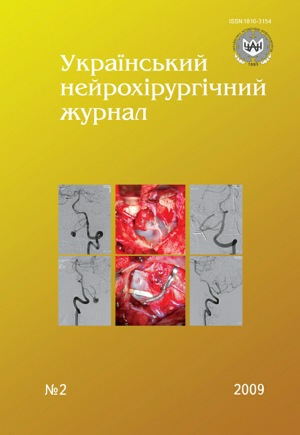Comparative estimation of surgical treatment methods of occlusive hydrocephaly
DOI:
https://doi.org/10.25305/unj.108636Keywords:
occlusive hydrocephaly, factors of occlusion, surgical treatment methods, endoscopic third ventriculostomy (ETV), Torkildsen operation, ventriculoperitoneal shuntingAbstract
The retrospective analysis of surgical methods for occlusive hydrocephaly (OH) treatment at 121 patients was carried out. On the basis of the treatment efficiency analysis taking into consideration patient’s age, level and factors of occlusion and disease phase the algorithm for method choice for OH surgical treatment was proposed that allowed to decrease frequency of postoperative complications from 31,94 to 22,45%, of repeated operations — from 30,56 to 16,32% and lethality from 12,5 to 6,12%.
References
Акшулаков С.К., Рабандияров М.Р., Муханов Т.К. Осложнения ликворошунтирующих операций, связанные с вторичными смещениями компонентов дренажной системы: Материалы семинара по гидроцефалии (г. Ступино, дек.1999 г.) // Нейрохирургия. — 2000. — №1–2. — С.81.
Балязин В.А. Вентрикулоцистернальный анастомоз по Торкильдсену — операция выбора при окклюзионной гидроцефалии: Материалы семинара по гидроцефалии (г. Ступино, дек.1999 г.) // Нейрохирургия. — 2000. — №1–2. — С.77.
Баратов В.В. Отдаленные результаты ликворошунтирующих операций: Автореф. дис. … канд. мед. наук. — СПб., 2000. — 24 с.
Вербова Л.Н., Шаверский А.В. Опухоли четверохолмной пластинки у детей // Материалы 5-й междунар. конф. „Актуальные вопросы нейрохирургии и неврологии”. — Хабаровск, 2001. — С.63–67.
Гренц Н.И., Ростоцкая В.И., Спиридонов И.В. Лечение окклюзионной гидроцефалии неопухолевого происхождения эндоскопическим способом // Вопр. нейрохирургии. — 1979. — №2. — С.3–8.
Зиненко Д., Владимиров М. Диагностика и лечение гипердренажных осложнений у недоношенных детей с постгеморрагической гидроцефалией // Материалы 4-го съезда нейрохирургов России. — М., 2006. — С.477.
Ким Вон Ги, Чмутин Г.Е., Чаус Ю.В.и др. Гидроцефалия при опухолях головного мозга супратенториальной локализации // Материалы 5-й междунар. конф. „Актуальные вопросы нейрохирургии и неврологии”. — Хабаровск, 2001. — С.82–84.
Коршунов А., Меликян А., Пецхилаури Д. и др. Выбор метода хирургического лечения гидроцефалии при опухолях задних отделов III желудочка: ETV или шунт? // Материалы 4-го съезда нейрохирургов России. — М., 2006. — С.482.
Меликян А.Г. Возможности и ограничения нейроэндоскопии в лечении больных с обструктивными формами гидроцефалии: анализ 10-летного опыта НИИ нейрохирургии им. академика Н.Н Бурденко РАМН // Материалы 4-го съезда нейрохирургов России. — М., 2006. — С.485.
Мирсадыков Д.А., Артарян А.А., Промыслов М.Ш., Арефьева И.А. О роли биохимических процессов в патогенезе осложненной водянки головного мозга у детей // Вопр. нейрохирургии. — 1999. — №4. — С.26–28.
Орлов Ю.А., Ткачик И.П., Шаверский А.В. и др. Воспалительные осложнения ликворошунтирующих операций // Укр. нейрохiрург. журн. — 2007. — №1. — С.44–48.
Пашаев Б., Иванов В., Данилов В. и др. Дисфункции современных шунтирующих клапанных систем у детей с гидроцефалией по материалам клиники детской нейрохирургии Казанского медицинского университета // Материалы 4-го съезда нейрохирургов России. — М., 2006. — С.487.
Рабандияров М.Р., Акшулаков С.К. Перитонеальные осложнения после ликворошунтирующих операций // Тез. докл. 3-го съезда нейрохирургов России. — СПб., 2002. — С.514.
Сафин Ш., Сафин А., Заитов И. Отдаленные результаты после ВПШ с применением лапароскопической техники // Материалы 4-го съезда нейрохирургов России. — М., 2006. — С.489.
Симерницкий Б.П., Петраки В.Л. К вопросу классификации гидроцефалии // Материалы 1-й Всерос. конф. по дет. нейрохирургии. — М., 2003. — С.75.
Файзуллаев Р.Б. Осложнения ликворошунтирующих операций: Автореф. дис. … канд. мед. наук. — Ташкент, 1999. — 19 с.
Хачатрян В.А. Итоги и перспективы изучения проблем гидроцефалии // Нейрохирургия и неврология дет. возраста. — 2005. — №3. — С.3–21.
Хачатрян В.А., Зуев И.В., Берснев В.П., Яцук С.Л. Хирургическая тактика при спинномозговых грыжах больших размеров, сочетающихся с гидроцефалией // Вопр. нейрохирургии. — 1995. — №1. — С.18–21.
AoyamaI., Kondo A., Nin K., Shimotake K. Pneumocephalus associated with benign brain tumor: report of two cases // Surg. Neurol. — 1991. — V.36, N1. — P.32–36.
Chong C.C., van Gelder J., Sheridan M. Clinical experience with the low pressure Novus valve in the treatment of adult hydrocephalus // J. Clin. Neurosci. — 2002. — V.9, N5. — P.539–543.
Hanlo P.W., Cinalli G., Vandertop W.P. et al. Treatment of hydrocephalus determined by the European Orbis Sigma Valve II survey: a multicenter prospective 5-year shunt survival study in children and adults in whom a flow-regulating shunt was used // J. Neurosurg. — 2003. — V.99, N1. — P.52–57.
Hopf N.J., Grunert P., Fries G. et al. Endoscopic third ventriculostomy: outcome analysis of 100 consecutive procedures // Neurosurgery. — 1999. — V.44, N4. — P.795–804.
Lo T.Y., Myles L.M., Minns R.A. Long-term risks and benefits of a separate CSF access device with ventriculoperitoneal shunting in childhood hydrocephalus // Dev. Med. Child Neurol. — 2003. — V.45, N1. — P.28–33.
McLone D.G., Dias M.S. The Chiari II malformation: cause and impact // Childs Nerv. Syst. — 2003. —V.19, N7–8. —P.540–550.
Xenos C., Sgouros S., Natarajan K. et al. Influence of shunt type on ventricular volume changes in children with hydrocephalus // J. Neurosurg. —2003. — V.98, N2. — P.277–283.
Downloads
Published
How to Cite
Issue
Section
License
Copyright (c) 2009 G. M. Kariev, N. Kh. Tukhtaev, N. Kh. Khalikov

This work is licensed under a Creative Commons Attribution 4.0 International License.
Ukrainian Neurosurgical Journal abides by the CREATIVE COMMONS copyright rights and permissions for open access journals.
Authors, who are published in this Journal, agree to the following conditions:
1. The authors reserve the right to authorship of the work and pass the first publication right of this work to the Journal under the terms of Creative Commons Attribution License, which allows others to freely distribute the published research with the obligatory reference to the authors of the original work and the first publication of the work in this Journal.
2. The authors have the right to conclude separate supplement agreements that relate to non-exclusive work distribution in the form of which it has been published by the Journal (for example, to upload the work to the online storage of the Journal or publish it as part of a monograph), provided that the reference to the first publication of the work in this Journal is included.









